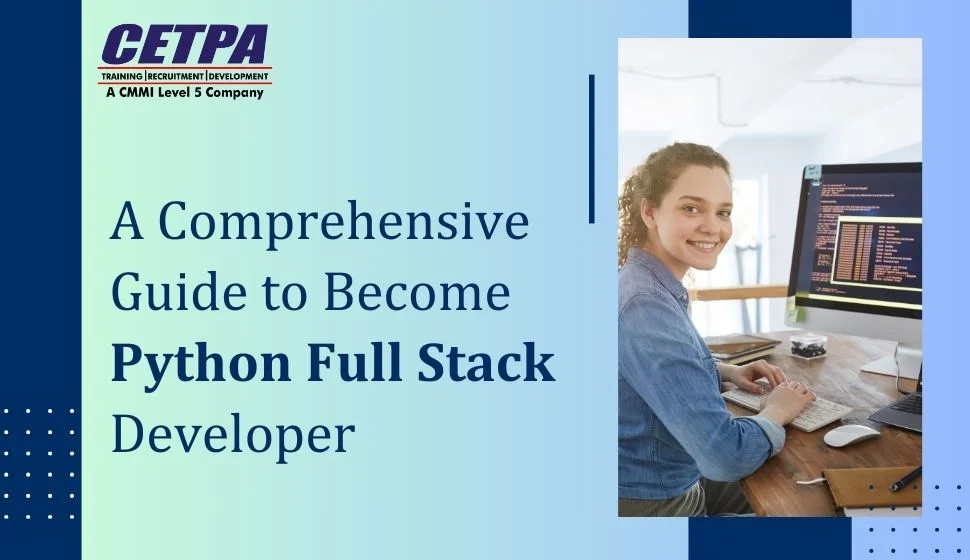A Comprehensive Guide to Become a Python Full Stack Developer

In the current tech-driven world, Python shines as a versatile and powerful programming language. Its simplicity and readability, integrated with a large ecosystem of libraries and frameworks, make it a perfect choice for full-stack development. Aspiring to become a Python Full Stack Developer means embarking on a rewarding journey to master both frontend and backend development using this popular language. Thus, with the right guidance and dedication, you can gain essential skills in Python programming, front-end technologies such as HTML, CSS, and JavaScript, as well as back-end frameworks like Django or Flask. This comprehensive guide will set you out on the path to becoming a skilled Python Full Stack Developer.
Understanding Full Stack Development:
As per our Python Full Stack Online Course or offline course, full stack development includes both frontend and backend components of a web application. As a full stack developer, one tends to wear multiple hats. This means that these professionals handle everything from building intuitive and responsive user interfaces using technologies such as HTML, CSS, and JavaScript, to managing server-side logic, databases, and server configuration.
Keeping that in mind, participants of the Python course are tasked with guaranteeing seamless integration between the front-end and back-end, optimizing performance, and delivering a user-friendly experience. Hence, full stack development mastery equips individuals to work on diverse projects independently or collaborate with specialized teams.
Why Python For Full Stack Development?
According to our Python Course, Python’s popularity in full stack development can be attributed to diverse factors. These factors include the following:
- Versatility: Python’s versatility permits developers to use it for both front-end and back-end development. This streamlines the development process and minimizes the need to switch between different programming languages.
- Rich Landscape: Python comprises a vast landscape of libraries and frameworks such as Django, Flask, and Pyramid. These frameworks and libraries offer pre-built modules and tools to speed up development and streamline complex tasks.
- Simplicity and Readability: Python’s straightforward syntax and readability make it convenient for developers to write clean and maintainable code. This further reduces the learning curve and improves productivity.
- Community Support: Python has a vast and active community of developers who contribute to its continuous improvement, share knowledge, and provide support through forums, tutorials, and open-source contributions.
- Scalability: With its robust performance and scalability, Python is well-suited for developing scalable and high-performance web applications. These web applications can further handle rising amounts of traffic and data.
- Integration Capabilities: Python provides seamless integration with other languages and platforms. This makes it easier to combine third-party services, APIs, and databases into web applications.
Who Is a Full Stack Developer?
A full stack developer is a multifaceted professional adept at handling both the front-end and back-end aspects of web development. These professionals may be considered as the Swiss Army Knife of the tech world. They are equipped with a diverse skill set that encompasses everything from building visually attractive user interfaces using HTML, CSS, and JavaScript, to orchestrating server-side logic, managing databases, and ensuring seamless data flow. Their role is similar to that of a conductor in an orchestra i.e., harmonizing different technologies and frameworks to build cohesive and functional web applications. With a holistic knowledge of the complete development process, full stack developers bridge the gap between design and functionality. This further makes them invaluable assets in the ever-changing digital world.
A Guide to Becoming a Python Full Stack Developer with a Python Course:
As per our top-rated Python course, the following comprehensive guide is the path to becoming a successful Python Full Stack Developer. Why wait then? Come, let’s explore the guide!
STEP 1: Learning Python Basics
Before delving into full stack development, it’s necessary to grasp the basics of Python programming. Aspirants must familiarize themselves with Python’s syntax and semantics, the various data structures as well as control structures.
STEP 2: Mastering Front-End Technologies
Aspiring individuals must be well versed in front end technologies. They must learn to build and style web pages using HTML and CSS. Also, they must gain proficiency in JavaScript to add interactivity to their web applications.
STEP 3: Diving Into Back-End Development with Python
In this step, aspiring developers must explore popular Python frameworks like Django and Flask while pursuing the Python course. Additionally, they must learn database management by combining databases such as PostgreSQL, MySQL, or MongoDB with Python applications.
STEP 4: Version Control with Git
To become a proficient Python Full Stack Developer, individuals must also master the fundamentals of Git for tracking changes in their codebase. They shall familiarize themselves with platforms such as GitHub or GitLab for collaborating with other developers and contributing to open-source projects.
STEP 5: Deploying Web Applications
Aspirants must understand the fundamentals of web servers such as Apache or Nginx. It is also necessary for them to learn how to deploy their Python applications on cloud platforms such as AWS, Azure, or Heroku.
STEP 6: Continuous Learning and Practice
The tech landscape is ever-evolving. Keeping this in mind, individuals must stay updated with latest trends, tools, and best practices in Python and full-stack development. Also, learners must build personal projects, contribute to open-source projects, or participate in hackathons to hone their skills.
Navigating The Challenges: Overcoming Hurdles Along The Way:
As you proceed toward mastery, you will surely encounter challenges and obstacles. Whether you’re recognizing cryptic troubles, dealing with complicated architectural decisions, or navigating the ever-changing currents of technological progress, remember that every obstacle is an opportunity for development. So, lean on your peers and mentors for support, make use of online networks and resources, and don’t be afraid to seek guidance and knowledge from those who have had this experience before. Their insights and experiences can provide invaluable perspectives and solutions to help you overcome challenges more effectively.
The Destination Awaits: Unleashing Your Potential as a Python Full Stack Developer
As you traverse through the maze of full stack development, keep in mind that the destination is not just a point on the map, but a state of mind. It is a state of mastery, proficiency, and boundless creativity. With Python as your compass and the knowledge gained in our Python course as your sail, set sail into the vast landscape of the digital world, for the world of possibilities awaits those who dare to dream and those who dare to master the art of full-stack development.
Becoming a Python Full Stack Developer is an intriguing journey filled with learning, challenges, and lucrative opportunities. By following the above comprehensive guide, you’ll be empowered with the necessary skills and knowledge required to begin a successful career in full stack development. So, why wait any longer? Join our Python Course in Noida today and take your career to the next level! Remember, continuous learning, practice, and passion are the keys to mastering Python full stack development.



